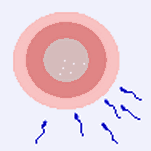|
绪论 - 什么是性行为? |
|
性行为当前的含义 3:
生殖行为 |
 |
|
受精
为了达到有性生殖的目的,雌性动物和雄性动物必须实施特定的行为过程。在哺乳动物,这个过程可以导致雌雄性器官的交接,并由此才能导致雌性性细胞(卵子)由雄性性细胞(精子)授精。可是,单有受精尚不足够,因为必须随后要有成功的怀孕和分娩。 Fertilization
For the purpose of sexual reproduction, a certain sequence of actions has to be performed by females and males. In mammals, this sequence may lead to a joining of their sex organs and this, in turn, can result on the fertilization of a female sex cell (egg) by a male sex cell (sperm). However, fertilization alone is never enough, because it has to be followed by a successful pregnancy and birth.
|
|
|
术语“性行为(sexual
behavior)”可以是指必需受精的所有举动和反应。
这是最狭义的定义。该定义表明每一个高等哺乳动物物种被分成两个性别群体,即雄性与雌性,它还表明它们行有性生殖。更确切地说,雄性与雌性动物产生不同而相互弥补的性细胞(配子)。当一个雄性性细胞(精子)与一个雌性性细胞(卵子)相遇并因而受精的时候,新生命便开始发育。为了达到受精的效应,雄性和雌性个体必须经历某些特有而非常精确和特殊的身体运动及其反应过程。这个过程(或这个过程的任何一部分)才被人适当地称作性行为(sexual
behavior)。
Introduction - What is sexual behavior?
Current Meanings of the Term 3: Reproductive Behavior
The term "sexual behavior" can refer to all actions and responses necessary for fertilization.
This is the narrowest definition. It reflects the observation that each species of the higher animals is divided into two groups or sexes, male and female, and that they reproduce sexually. That is to say, males and females produce different but complementary sex cells (gametes). New life may begin to develop when a male sex cell (spermatozoon) unites with and thus fertilizes a female sex cell (ovum). In order to effect this fertilization, a male and a female individual have to go through a certain characteristic and very specific sequence of physical motions and responses. This sequence (or any part of it) is properly called sexual behavior.
|